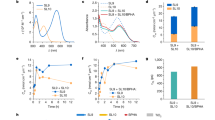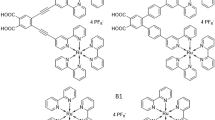Abstract
Low-cost renewable energies are necessary for the realization of a low-carbon society. Organic photovoltaics such as organic thin-film solar cells1,2 and dye-sensitized solar cells (DSSCs)3,4 are promising candidates for realizing low-cost solar cells. However, device efficiencies are still considerably lower than those of traditional inorganic solar cells. To improve organic photovoltaic performance, approaches are needed to extend the absorption of organic compounds to longer wavelengths. Here, we report efficient DSSCs that exploit near-infrared, spin-forbidden singlet-to-triplet direct transitions in a phosphine-coordinated Ru(II) sensitizer, DX1. A DSSC using DX1 generated a photocurrent density of 26.8 mA cm−2, the highest value for an organic photovoltaic reported to date. A tandem-type DSSC employing both DX1 and the traditional sensitizer N719 is shown to have a power conversion efficiency of >12% under 35.5 mW cm−2 simulated sunlight.
This is a preview of subscription content, access via your institution
Access options
Subscribe to this journal
Receive 12 print issues and online access
$209.00 per year
only $17.42 per issue
Buy this article
- Purchase on Springer Link
- Instant access to full article PDF
Prices may be subject to local taxes which are calculated during checkout



Similar content being viewed by others
References
Halls, J. J. M. et al. Efficient photodiodes from interpenetrating polymer networks. Nature 376, 498–500 (1995).
Yu, G., Gao, J., Hummelen, J. C., Wudl, F. & Heeger, A. J. Polymer photovoltaic cells: enhanced efficiencies via a network of internal donor–acceptor heterojunctions. Science 270, 1789–1791 (1995).
O'Regan, B. & Grätzel, M. A low-cost, high-efficiency solar cell based on dye-sensitized colloidal TiO2 films. Nature 353, 737–740 (1991).
Grätzel, M. Photoelectrochemical cells. Nature 414, 338–344 (2001).
Peet, J. et al. Efficiency enhancement in low-bandgap polymer solar cells by processing with alkane dithiols. Nature Mater. 6, 497–500 (2007).
Xia, Y. et al. Photocurrent response wavelength up to 1.1 µm from photovoltaic cells based on narrow-band-gap conjugated polymer and fullerene derivative. Appl. Phys. Lett. 89, 081106 (2006).
Nazeeruddin, M. K. et al. Combined experimental and DFT–TDDFT computational study of photoelectrochemical cell ruthenium sensitizers. J. Am. Chem. Soc. 127, 16835–16847 (2005).
Nazeeruddin, M. K. et al. Engineering of efficient panchromatic sensitizers for nanocrystalline TiO2-based solar cells. J. Am. Chem. Soc. 123, 1613–1624 (2001).
Onozawa-Komatsuzaki, N. et al. Near-IR dye-sensitized solar cells using a new type of ruthenium complexes having 2,6-bis(quinolin-2-yl)pyridine derivatives. Solar Ener. Mater. Solar Cells 95, 310–314 (2011).
Yanagida, M. et al. Panchromatic sensitization of nanocrystalline TiO2 with cis-bis(4-carboxy-2-[2′-(4′-carboxypyridyl)]quinoline)bis(thiocyanato-N)ruthenium(II). Inorg. Chem. 42, 7921–7931 (2003).
Funaki, T. et al. Synthesis of a new class of cyclometallated ruthenium(II) complexes and their application in dye-sensitized solar cells. Inorg. Chem. Commun. 12, 842–845 (2009).
Barolo, C. et al. Synthesis, characterization, and DFT–TDDFT computational study of a ruthenium complex containing a functionalized tetradentate ligand. Inorg. Chem. 45, 4642–4653 (2006).
Altobello, S. et al. Sensitization of nanocrystalline TiO2 with black absorbers based on Os and Ru polypyridine complexes. J. Am. Chem. Soc. 127, 15342–15343 (2005).
Yamaguchi, T., Miyabe, T., Ono, T. & Arakawa, H. Synthesis of novel β-diketonate bis(bipyridyl) Os(II) dyes for utilization of infrared light in dye-sensitized solar cells. Chem. Commun. 46, 5802–5804 (2010).
Gao, S., Islam, A., Numata, Y. & Han, L. A β-diketonato ruthenium(II) complex with high molar extinction coefficient for panchromatic sensitization of nanocrystalline TiO2 film. Appl. Phys. Express 3, 062301 (2010).
Kalyanasundaram, K. Photochemistry of Polypyridine and Porphyrin Complex (Academic Press, 1992).
Crosby, G. A. & Demas, J. N. Quantum efficiencies on transition metal complexes. II. Charge-transfer luminescence. J. Am. Chem. Soc. 93, 2841–2847 (1971).
Sullivan, B. P., Calvert, J. M. & Meyer, T. J. Cis–trans isomerism in (trpy)(PPh3)RuCl2. Comparisons between the chemical and physical properties of a cis–trans isomeric pair. Inorg. Chem. 19, 1404–1407 (1980).
McGlynn, S. P., Sunseri, R., Christodouleas, N. External heavy-atom spin–orbital coupling effect. I. The nature of the interaction. J. Chem. Phys. 37, 1818 (1962).
McGlynn, S. P., Azumi, T. & Kinoshita, M. Molecular Spectroscopy of the Triplet State (Prentice-Hall, 1969).
Montalti, M., Credi, A., Prodi, L. & Gandolfi, M. T. Handbook of Photochemistry 3rd edn (CRC Press, 2006).
Sauvé, G. et al. Dye sensitization of nanocrystalline titanium dioxide with osmium and ruthenium polypyridyl complexes. J. Phys. Chem. B 104, 6821–6836 (2000).
Ghosh, S. et al. Electronic structures and absorption spectra of linkage isomers of trithiocyanato (4,4′,4′′-tricarboxy-2,2′:6,2′′-terpyridine) ruthenium(II) complexes: a DFT study. Inorg. Chem. 45, 7600–7611 (2006).
Koops, S. E., O'Regan, B. C., Barnes, P. R. F. & Durrant, J. R. Parameters influencing the efficiency of electron injection in dye-sensitized solar cells. J. Am. Chem. Soc. 131, 4808–4818 (2009).
Huang, S. Y., Schlichthörl, G., Nozik, A. J., Grätzel, M. & Frank, A. J. Charge recombination in dye-sensitized nanocrystalline TiO2 solar cells. J. Phys. Chem. B 101, 2576–2582 (1997).
Kim, J. Y. et al. Efficient tandem polymer solar cells fabricated by all-solution processing. Science 317, 222–225 (2007).
Yanagida, M. et al. Optimization of tandem-structured dye-sensitized solar cell. Solar Ener. Mater. Solar Cells 94, 297–302 (2010).
Durr, M., Bamedi, A., Yasuda, A. & Nelles, G. Tandem dye-sensitized solar cell for improved power conversion efficiencies. Appl. Phys Lett. 84, 3397–3399 (2004).
Kubo, W., Sakamoto, A., Kitamura, T., Wada, Y. & Yanagida, S. Dye-sensitized solar cells: improvement of spectral response by tandem structure. J. Photochem. Photobiol. A 164, 33–39 (2004).
Honda, S., Ohkita, H., Benten, H. & Ito, S. Multi-colored dye sensitization of polymer/fullerene bulk heterojunction solar cells. Chem. Commun. 46, 6596–6598 (2010).
Acknowledgements
The authors thank Hamamatsu Photonics K.K. for help with photophysical measurements. This work was supported by a Funding Program for World Leading Innovative R&D on Science and Technology (FIRST Program) on Organic Photovoltaics, and by Research Fellowships of the Japan Society for the Promotion of Science (JSPS) for Young Scientists (22-10095).
Author information
Authors and Affiliations
Contributions
T. Ki. and H.S. initiated the work and designed the research. T. Ki. synthesized the DX1 and performed measurements. J.T.D., S.U. and T. Ku. provided technical advice on the device design. All authors performed and analysed the experiments. T. Ki. wrote the text with the assistance of H.S.
Corresponding author
Ethics declarations
Competing interests
The authors declare no competing financial interests.
Supplementary information
Rights and permissions
About this article
Cite this article
Kinoshita, T., Dy, J., Uchida, S. et al. Wideband dye-sensitized solar cells employing a phosphine-coordinated ruthenium sensitizer. Nature Photon 7, 535–539 (2013). https://doi.org/10.1038/nphoton.2013.136
Received:
Accepted:
Published:
Issue Date:
DOI: https://doi.org/10.1038/nphoton.2013.136
This article is cited by
-
The Use of Copper-Quercetin Complex as Photosensitizer in Dye Sensitive Solar Cells and Its Photovoltaic Performance
Brazilian Journal of Physics (2023)
-
Stacked nanocarbon photosensitizer for efficient blue light excited Eu(III) emission
Communications Chemistry (2020)
-
Improved light harvest in diffraction grating-embedded TiO2 nanoparticle film
Applied Physics A (2017)
-
Comprehensive approach to simulate vibrationally resolved phosphorescence spectra of gold(III) complexes using DFT including temperature effects
Theoretical Chemistry Accounts (2017)
-
Wrinkled silica/titania nanoparticles with tunable interwrinkle distances for efficient utilization of photons in dye-sensitized solar cells
Scientific Reports (2016)



